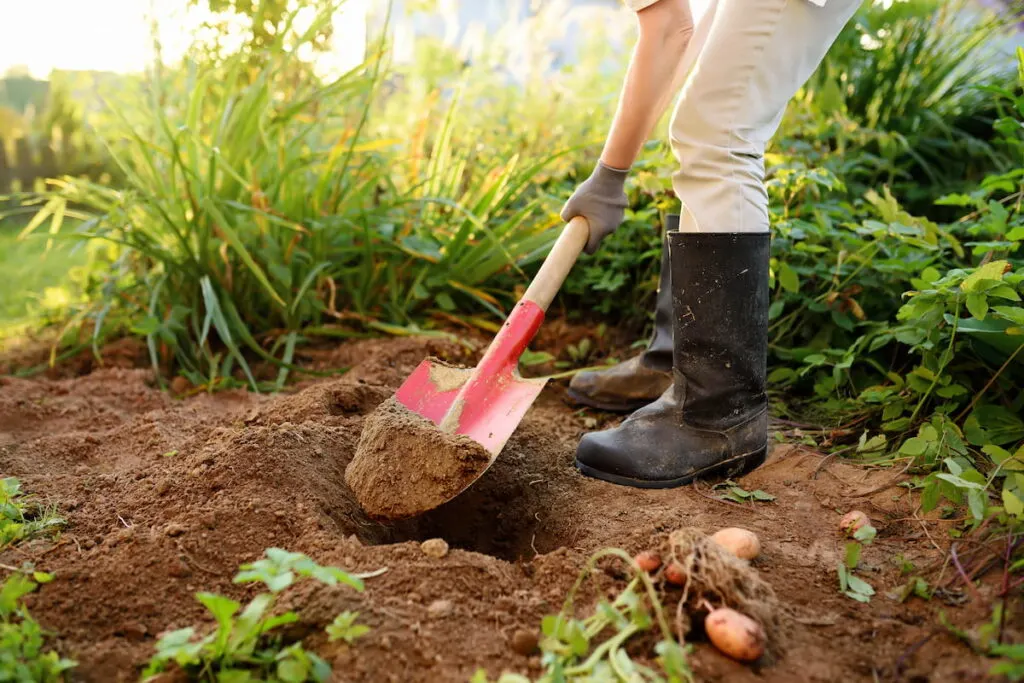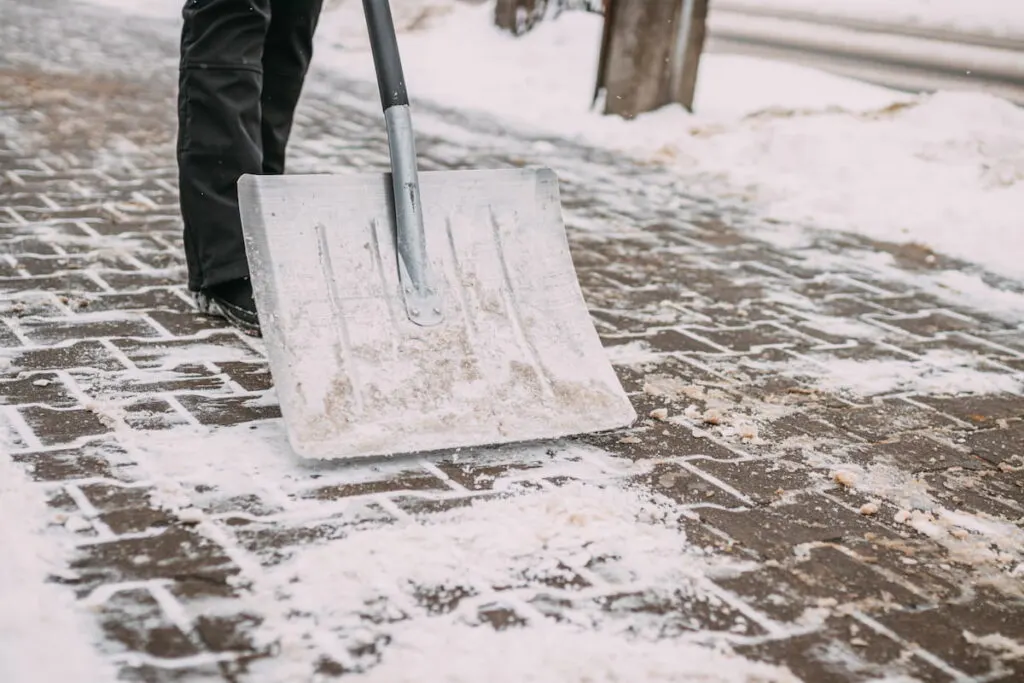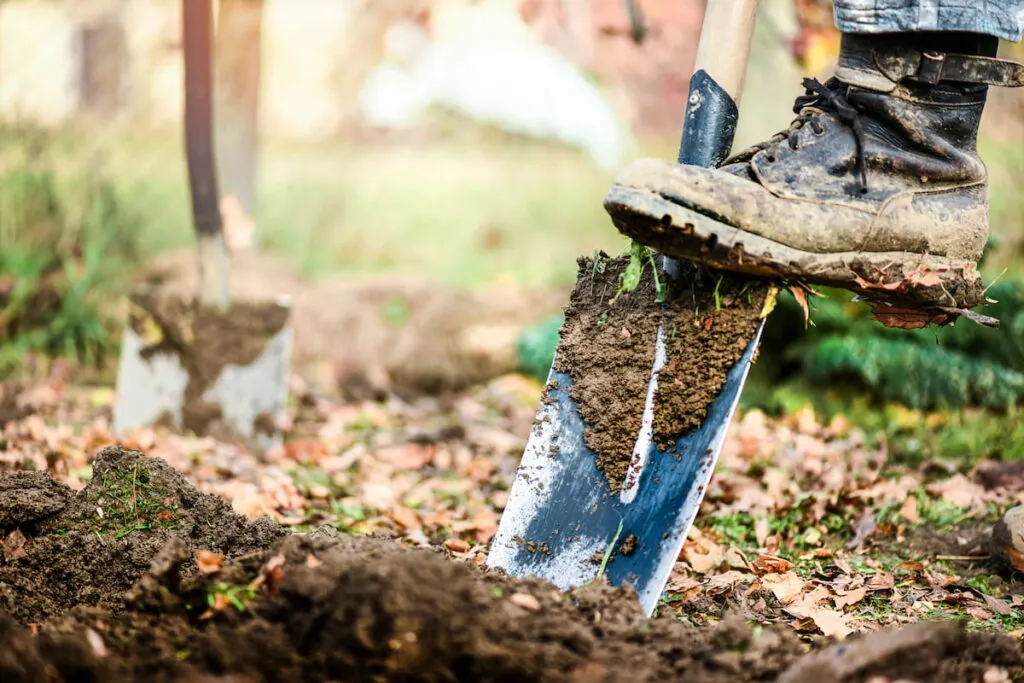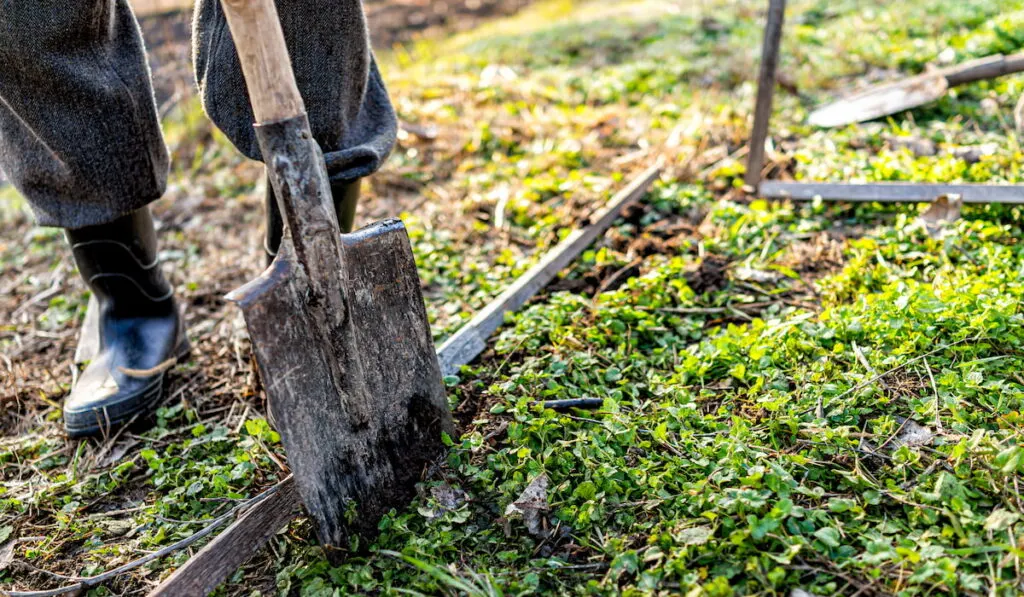Call a shovel a shovel and not a spade! And if you wonder how to distinguish between these two gardening tools, you are not alone.
Whether you are a seasoned gardener or a beginner, shovels and spades are common in soil-working activities. But their similarity can confuse you.
Although they may look similar, a shovel differs from a spade in many aspects.
Scooping and lifting material, slicing and cutting soil, and edging your lawn are some of the uses of shovels and spades.
Explore the types of shovels and spades, their uses, and their differences in this article.

Table of Contents
Shovels
A shovel is a gardening tool with a deeper bowl and greater curve. You can use it for scooping and moving large amounts of material such as manure, soil, and mulch.
In addition to moving material, a shovel comes in handy when cleaning concrete floors and pavements. You can use it to scrape off material using the flat end.
Shovels come in varying shapes and sizes. Here are the major types.

Types of Shovels
1. Tree Planting Shovel
The tree planting shovel has a narrow blade curved at the tip. As the name suggests, you can use it for tree planting.
Its sharp blade lets you scoop tree seedlings from the nursery and dig holes for planting. You can also use it to create shallow trenches for your flower beds.
2. Round-point Shovel
A round point shovel has a blade with curved edges and tip. If you are digging holes in loose soil, this tool is ideal.
You can use this shovel when digging and transplanting trees.

3. Snow Shovel
A snow shovel has a long wooden or metallic handle with a rectangular plate. You can use it for clearing ice if you live in cold regions.
The large rectangular blade and long handle enhance the scooping of large amounts of ice and other material.
Some snow shovels have metal grooves on the blade to help when removing snow.
Snow shoveling can cause back pain from too much bending.
Some snow shovel designs allow you to clear ice and snow away without exhaustion.
4. Scoop Shovel
A scoop shovel has a wider blade with higher sides and comes in different widths and depths. You can use it to scoop different materials including gravel, mulch, and soil.
The blade can be made of different materials. Some are heavier and ideal for lifting heavy materials such as gravel.
If you are scooping light material such as mulch and grass clippings, go for the lighter versions.
Uses
You can use a shovel for different tasks in your garden or construction site. The primary uses include:
- Digging trenches
- Creating post holes
- Scooping and carrying material
- Breaking soil and stone into smaller particles
- Leveling, smoothing, and distributing materials such as sand and gravel in construction sites

Spades
A spade has a flat face and is shallower. It has a long handle and a sharp blade. You can use it for digging, piercing, and cutting soil.
Types of Spades
Spades come in varying designs and sizes, as outlined below.
1. Pointed Spade
A pointed spade has a short, wide blade. The blade is sharpened to a point hence its name.
This multipurpose garden tool has a long, smooth handle with wide foot treads.
The pointed spade can cut through hard ground and remove tough roots.
Its smooth, long handle makes it comfortable to hold while the sharp, wide blade helps lift material easily.
2. Trenching Spade
A trenching spade helps you to create narrow, flat-bottomed trenches. This spade has sharply pointed tips and square sides.
Its shape helps you to create trenches with clean, smooth walls. This ensures they are not washed away by erosion.
This spade has long handles and flat upturned surfaces on the blade. The surface helps you remove soil from the trench after digging.
This tool is ideal whether you want to install underground pipes for irrigation or dig composite trenches.
3. Border Spade
A border spade is great for planting, especially in raised beds that require minimal disturbance. It has stainless steel, wooden and plastic handles, and a narrow, sharp blade.
This makes it perfect for cutting through the soil. Since they frequently scoop up chunks of soil, you probably wonder how to clean them.
But their smooth surfaces make them non-stick.

4. Digging Spade
Digging spades have long handles and narrow, flat blades. The long handles help you dig without much bending.
Their handles have Y-shaped grips with a strapped socket at the joint. This makes it durable.
The flat blades pierce the soil without holding earth material, making the tool light and comfortable to use.
5. Drain Spade
If you want to dig narrow trenches and deep holes for planting, a drain spade is perfect. Its blade is made of heavy-duty steel which makes it easy to break hard soil.
The narrow blade penetrates through hard soil and mud, and the long handle saves you from back pain.
Drain spades are made of stainless steel, fiberglass, and polyester. The material you choose depends on your use.
Using the digging spade, you can clean trenches, remove mud from holes, or transplant trees.
Uses
The uses of spades vary depending on the type.
Here are the everyday tasks you can do in your garden using a spade:
- Cutting and slicing soil
- Edging and shaping lawns and gardens
- Creating trenches and holes
- Lifting soil in garden beds and transplanting trees
Differences Between Shovels and Spades
Shovels and spades look similar, and we often interchange their functions. However, they have outstanding differences in their shapes, size, and uses.
The table below highlights the differences between a shovel and a spade.
| Feature | Shovel | Spade |
| Shape | Pointed tip. Big and wide blade. Deep curved face. | Flat tip. Small and flat blade. Shallow face. |
| Uses | Moving materials. Breaking blocks of soil to fine particles. Leveling, smoothing, and distributing material during construction. | Cutting soil and digging holes. Creating and cleaning trenches. Transplanting trees. |
| Handles | D-Shaped at the top for gripping. | Y-shaped at the top for gripping. |
Shovel vs. Spade: Choosing the Right Tool
Shovels and spades perform similar functions. However, you need to choose the right tool for your task to make your work easier and more enjoyable.
The following factors are important when choosing a spade or shovel.
- Comfort while using. Choose a spade or shovel with the right style handle and grip to keep your hands comfortable.
Also, pick a handle length that saves you from bending too much to keep your back comfortable.
- What tasks do you perform mostly? Shovels and spades have a wide range of uses. Therefore, choose a tool that meets your needs.
For example, if you are doing construction, a heavy-duty shovel is ideal because it can lift rough and heavy materials like gravel and stones.
- Affordability. Shovels and spades are made of different materials for the handle and blade. Some are pretty costly.
When choosing one, pick a quality tool without straining your budget.

Parting Shot
Shovels and spades are essential tools in our homes. Whether you want to modify your kitchen garden, improve your yard, or keep your lawn neat, these tools will always come in handy.
You should pick the shovel that best suits the job you are doing. Although they perform similar functions, the two tools are made for different uses.
Therefore, evaluate the common tasks around your home and property and pick the most suitable shovel or spade for your needs.
Resources
- https://garrettwade.com/blog/shovels-and-spades-whats-the-difference/
- https://www.trees.com/gardening-and-landscaping/types-of-shovels
- https://www.gardenersworld.com/reviews/tools/planting/sneeboer-pointed-spade-with-steps-review/
- https://www.gardenersworld.com/reviews/tools/planting/best-garden-spades/
- https://www.burgonandball.com/products/digging-spade-rhs-endorsed
- https://www.lowes.com/pl/Drain-spade–Shovels-spades-Digging-tools-Lawn-garden-hand-tools-Outdoor-tools-equipment-Outdoors/4294612716?refinement=4294716118
- https://www.sowanddipity.com/a-shovel-and-a-spade/
- https://www.workshop.bunnings.com.au/t5/How-To/How-to-select-a-shovel-or-a-spade/ba-p/109593
